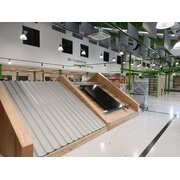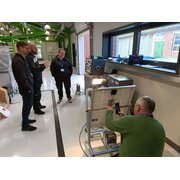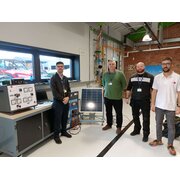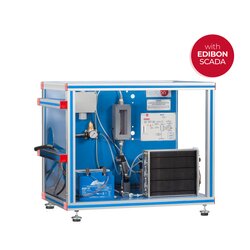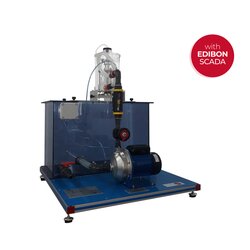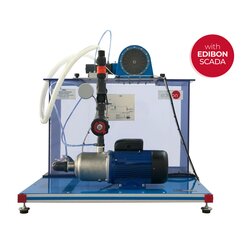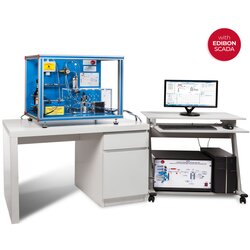Photovoltaic Solar Energy Modular Trainer (MINI-EESF)
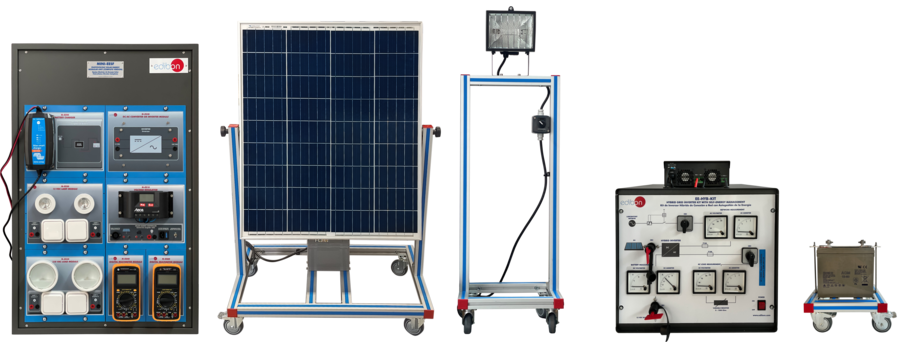


PL-738109
The “MINI-EESF” Photovoltaic Solar Energy Modular Unit (Complete Version) designed by EDIBON is a laboratory-scale system designed to comprehensively explore the parameters involved in the direct conversion of solar radiation into electricity. This unit features application modules and photovoltaic solar panels mounted on mobile structures, enabling flexibility and ease of use.
The MINI-EESF unit is tailored for both theoretical and practical studies of photovoltaic solar energy systems, including the typical configurations found in solar installations and the operation of various components involved in energy conversion.
The solar energy captured can be utilized in several ways:
- Regulated DC Power: The system can charge batteries while monitoring parameters such as the current output from the solar modules and the battery voltage.
- DC Loads: The unit can deliver power directly to DC loads, allowing for the analysis of solar module output and the current consumption of connected devices.
- AC Power Conversion: The system can convert the solar energy into AC power for use by AC loads, facilitating the study of load consumption patterns.
- Public Grid Injection: Users can simulate the injection of energy into the public grid, examining output current and voltage from the solar modules, as well as power supplied to the grid, including frequency and voltage metrics.
The MINI-EESF unit is available in two different versions, offering varying practical applications and levels of complexity: MINI-EESF/M and MINI-EESF/B. This flexibility makes it an ideal educational tool for understanding solar energy systems and their integration into electrical installations.
- MINI-EESF. Unit:
- Supply and Consumption at 12 VDC.
- Supply and Consumption in alternating current (AC).
- Supply to the electrical grid.
- Photovoltaic module.
- Lamp module.
- Battery offering optimal performance with low power applications.
- Set of interconnection cables.
The “MINI-EESF” unit includes the following elements:
- EE-HYB-KIT. Hybrid Grid Inverter Kit with Self-Energy Management.
- MINI-EESF/M. Photovoltaic Solar Energy Modular Unit (Intermediate Version).
- Cables and Accessories, for normal operation.
- Manuals: This unit is supplied with 8 manuals. Required services, Assembly and Installation, Interface and Control software, Starting-up, Safety, Maintenance, Calibration and Practices manuals.
EXERCISES AND PRACTICAL POSSIBILITIES TO BE DONE WITH THE MAIN ITEMS
- Determination of the constituent material of the solar cell.
- Determination of the I-V first quadrant curve without illuminating the solar cell.
- Determination of the inverse (or saturation) current of the cell without illumination.
- Determination of parallel and series resistance of a solar cell without illumination.
- Dependency of the open circuit voltage (Voc) with lumens (luminous flux).
- Determination of the parameters that describe the quality of a solar cell.
- Solar energy measurement.
- Measurement of the solar panel voltage with no load.
- Determination of the disposition of cells in a solar panel.
- Familiarisation with the regulator parameters.
- Loads connection to 12 VDC.
- Loads connection to 220 VAC.
- Study of the inverter with grid connection.
- Battery charging.
- Practices of serial and parallel panel configuration (minimum two MINI-EESF units).
- Study of the hybrid inverter’s grid connection procedure: correct sequence of battery and grid switches (EE-HYB-KIT).
- Study of the hybrid inverter configuration (EE-HYB-KIT).
- Study of the hybrid inverter in grid connection mode (EE-HYB-KIT).
- Study of the hybrid inverter in island mode (EE-HYB-KIT).
- Study of the behavior of the hybrid inverter in the event of a blackout (EE-HYB-KIT).
- Study of the charging process of the battery from the laboratory grid through the hybrid inverter (EE-HYB-KIT).
- Study of the battery charging process from a renewable energy source (EE-HYB-KIT).
- Study of the power flows of the battery and the grid under variations of the energy demand with the variable resistive load (EE-HYB-KIT).
- Study of the response of the hybrid inverter when the critical discharge point of the battery is reached (EE-HYB-KIT).
- Study of the energy balance between the battery-charge-grid by means of the analog ammeters and voltmeters incorporated in the kit (EE-HYB-KIT).
What is this?
These percentage scores are an average of 0 user reviews. To get more into detail, see each review and comments as per below
If you have used this product, support the community by submitting your review


